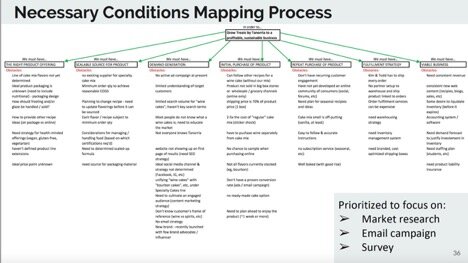We’ve recorded a number of podcasts lately. Somewhere in the conversation we get asked this question, “What do you say to the entrepreneur who feels overwhelmed and can’t figure out where to start?” We tend to see two different approaches. First, there are those entrepreneurs who just start doing things. Sometimes doing creates momentum and that’s a good thing. But their activity is kind of scattered because they don’t really have a plan. On the other hand, we also see entrepreneurs who plan, plan, plan but never really take any action. So, we thought we would share the NOW and the NEXT as a way to help you figure out what to do tomorrow.
At a mountain biking clinic in Utah, we were introduced to the concept of NOW and NEXT. When mountain biking, it is important to focus on where you are NOW—the immediate surroundings, what is underfoot, where to bail if needed, and how to avoid rocks or roots that can take you down. Think about what is under your bike and one-to-two seconds in front of you. The NEXT, however, is equally important. You must also be constantly scanning ten-to-twenty feet or three-to-six seconds ahead to see where the trail is going and what obstacles might come up immediately. This scanning tells you where the trail is heading so you can make the necessary adjustments to align yourself appropriately.
As professional Mountain Bike Instructor and Trek Advocate Kate Nolan of DNK Presents notes: “One of the lessons I teach is terrain awareness - scanning and collecting information from the Now and the Next to learn how to ride more efficiently on technical terrain. We collect more information about the trail and better react and adapt to the ever-changing conditions through constant scanning. In order to be successful on the trail, you can’t only look at the Now or only focus on the Next. The best riders effectively use both the Now and the Next for a more controlled, efficient and confident ride.”
Founders must similarly pay attention to NOW’s choices and actions, as well as where the startup is heading NEXT. The NOW for founders incorporates the immediate tasks that they need to do to move forward. Whether researching website domain availability, visiting with potential customers, exploring support from advisors, or experimenting with early versions of the product, there is always a plethora of tasks a founder must undertake.
The NEXT for startups involves what happens in the coming days and weeks. Collecting and digesting patterns of feedback from customers, advisors, and others helps make sure the startup is on track. Filling orders and unloading pallets must be balanced with finding the next customer or investor, designing the next feature, and finding the next salesperson.
So, how do you know what is NOW and what is NEXT? You have to create some basic kind of map. Here are two examples we’ve used – Necessary Conditions Mapping and a Fishbone Diagram…except, we would do the fishbone in reverse. Let’s talk about the necessary conditions map first. For this, you have to list your ultimate goal and work backwards – what has to happen to get to that goal. Then within each of the activities, again list all of the tactics that have to happen for that Activity to be complete. Finally, prioritize across the major activities to get to your NOW. The rest of the map is the NEXT.
A fishbone diagram comes from Lean Six Sigma and it asks you to start with the defect you want to fix on the right. Instead of a problem, use the ultimate goal from above. Again, work backwards, brainstorming the cause and effect of getting to that goal. Visit GoLeanSixSigma and download a template. The biggest causes are your NOW. And the rest is part of your NEXT.
To avoid many of the icebergs across Oceans, navigating uncertainty requires scanning for the NEXT series of activities and icebergs. Keep your focus on the NOW, but stay alert to the NEXT. Fires will certainly come up that need immediate attention—but systematic review of the NEXT can minimize the fires and make sure your ship stays on course.



